Unexpected Microprocessor History
You think it all started with an Intel 4004, but it's not that simple.
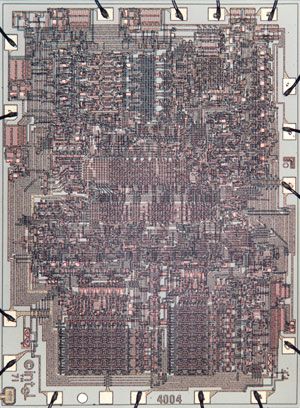
Intel 4-bit 4004
Transistors, electronic amplifiers and switches, which are now at the center of everything, from a pocket radio receiver to a supercomputer, were invented in 1947. Early prototypes were called bipolar transistors, and they are still running. By the 1960s, engineers had figured out how to combine several bipolar transistors on a single integrated circuit. But due to their complex structure, only a small number of them could be on the diagram. Therefore, although a mini-computer based on bipolar integrated circuits was much smaller than early computers, it required several motherboards with hundreds of chips on them.
')
In 1960, a new type of transistor was shown: a metal-oxide-semiconductor transistor, a MOSFET. At first, the technology did not look promising. They were slower, less reliable and more expensive than bipolar. But by 1964, the integrated circuits on MOS transistors could already boast of greater density and lower cost of production than bipolar. The complexity of integrated circuits grew according to Moore's law, but the MOS technology took the lead.
By the end of the 1960s, there could already be about 100 logical elements on one MOS chip, each of which had several transistors, and it all looked promising for creating computers. These multicomponent chips were called IEDs, high-level integration [large-scale integration, LSI].
Engineers realized that the increasing density of MOS transistors will allow to place the computer processor on a single chip. But due to the fact that MOS transistors were slower than bipolar, the computer on MOS chips made sense only where a small speed or light and compact device was needed - data terminals, calculators, aerospace electronic equipment. So what exactly with such scopes began revolution of microprocessors.
Most of today's engineers believe that the revolution began in 1971, with a 4-bit chip from Intel, 4004, which was immediately followed by an 8-bit chip 8008. But the history of the birth of the microprocessor is much richer and more surprising. In particular, some of the newly discovered documents show how the chip, which was forgotten today, Texas Instruments TMX 1795, overtook the Intel 8008 and became the first 8-bit microprocessor, but then sunk into oblivion.
The path to the first microprocessor paved the use of MOS chips in the computer field. The first computer based on the MOS-IWU was the D200, created in 1967 by Autonetics, a division of North American Aviation, located in Anaheim, California.
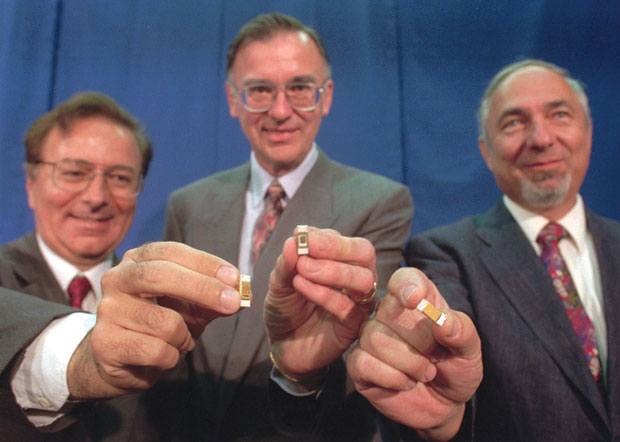
Three proud fathers: Federico Faggin, Marcian Hoff Jr. and Stanley Meizor pose in the Hall of Fame of the inventors, demonstrating the Intel 4004 microprocessor.
Compact 24-bit universal computer was designed for aviation and navigation. Its processor was built from 24 MOS chips and used four-phase logic, using four different clock signals. Each signal with its own on and off circuit, or phase, controlled the state changes of the transistors, which led to a simplification of the circuit. Being only a few kilograms in weight, the computer was used to navigate a Poseidon class ballistic missile launched from submarines and to control the fuel on a B-1 bomber. He even thought to put on the space shuttle.
Soon after, the D200 was followed by another aviation computer with three processors and a total of 28 chips: Central Air Data Computer by Garrett AiResearch (now part of Honeywell). The computer was used to control the flight of the F-14 fighter, using the MP944 MOS-LSI chipset, developed in the company from 1968 to 1970. A 20-bit computer processed information from sensors and gave out data for a set of equipment and aircraft control.
The architecture of the computer for the F-14 was unusual. It had three functional modules operating in parallel: one for multiplication, one for division, and one for special logic functions (for example, holding the value between the upper and lower limits). Each module consisted of several different MOS chips, such as a persistent storage device containing data defining the operation of the module; data management chip; various arithmetic chips; and random access memory for temporary storage.
Computer F-14 was classified, so few people knew about the MP944 chipset. But Autonetics widely covered its D200, which inspired the creation of an even more compact MOS computer: System IV. He was the brainchild of Lee Boycel, who left Fairchild Semiconductor in 1968 to establish Four-Phase Systems, a company he named after four-phase logic.
The 24-bit System IV processor was made from a total of nine MOS chips: three arithmetic logic (ALU) modules, whose design was called AL1 (performed arithmetic operations like addition and multiplication, as well as logical operations, AND, OR AND NOT), three ROM chips and three chips with random logic generation.

TMX 1795, 3,078 transistors

4004, 2 300 transistors
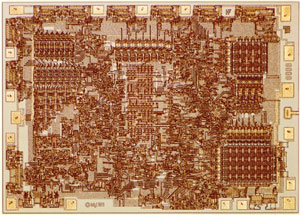
8008, 3,098 transistors
Almost at the same time, a startup from Massachusetts Viatron Computer Systems entered the game. Just a year after its launch in November 1967, the company announced the System 21, a 16-bit mini-computer with various accessories, built on the basis of self-made MOS chips.
They invented the word "microprocessor". The company first used it in an announcement in October 1968, when it announced a project called 2101. But it wasn’t a chip — in Viatron’s terminology this word meant part of a small terminal with a keyboard and a tape drive connected to a separate mini-computer. This “microprocessor” controlled the terminal and consisted of 18 special MOS chips on three boards.
And during this parade, in the late 1960s, the Japanese calculator manufacturer Business Computer Corp. (better known as Busicom), ordered Intel to make chips for a multi-chip calculator. The final product consisted of a single-chip processor, now known as the Intel 4004, with accompanying memory and I / O chips. 4-bit 4004 (manipulated data of 4 bits) is often considered the first microprocessor.
The 4004th calculator was first released in early 1971. He had many competitors. The semiconductor company Mostek issued the first “calculator on a chip,” MK6010. Pico Electronics and General Instrument had a G250 calculator. Six months later, TMS 1802 from Texas Instruments was launched, and it was the first chip in the highly successful 0100 series. These schemes worked well as a calculator, but didn’t know much more, but 4004 followed the instructions stored in the ROM. He could be a general-purpose computer.
It was a time of rapid change for electronic calculators, and after financial difficulties appeared, Busicom sold its exclusive rights to 4004. In November 1971, Intel began manufacturing its and auxiliary chips as an end product for general computer computing. After a few months, 4004 eclipsed more powerful microprocessors, so its commercial success was small. He worked in several pinball machines, a word processor and a machine for counting votes.
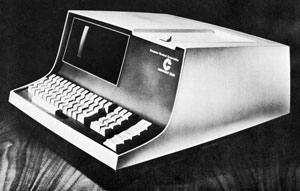
Datapoint terminal 2200
So the first 4-bit microprocessor was generated by a calculator. And the 8-bit microprocessors that quickly replaced him had a completely different origin. Their story began in 1969 with the development of the Datapoint 2200 “programmable terminal” at Computer Terminal Corp. (CTC) from San Antonio, Texas.
The Datapoint 2200 was a general-purpose computer, not just a terminal. Initially, an 8-bit microprocessor was built on 100 bipolar chips. The developers were looking for ways to reduce energy consumption and heat generation. In early 1970, CTC agreed with Intel to build a single MOS chip to replace the processor board, although it is not clear which of them decided to use the processor on a single chip.

Gary Boone at TI led the development of TMX1795
By June 1970, Intel developed the chip specification for the Datapoint 2200 architecture, and then froze the project for 6 months. This design will soon be implemented in the Intel 8008. So what, then, whether the 4004 inspired by the calculator, or the 8008 inspired by the terminal, the creation of a general-purpose microprocessor should be attributed to Intel, right? Not really.
The fact is that in 1970, when Intel started developing 8008, it was a startup of 100 people. Having learned about the development, the giant company Texas Instruments, consisting of 45,000 people, offered its services to ITS to develop a processor for the Datapoint 2200 terminal. ITS issued TI specifications and gave the green light. When they returned with the design for the three chips, the JTS politely asked if they could make the design on a single chip, as Intel did. TI took up the processor's single-chip design in April 1970. The work was completed the following year, the chip was named TMX 1795 (X from “experimental”), and the name later turned into TMC 1795 when it ceased to be a prototype.
In June 1971, TI launched an ad for TMC 1795, telling how this “single-chip CPU” would be used in the Datapoint 2200, “a powerful computer with features that the previous version did not have.” But this did not happen - having checked the TMC 1795, the CTC rejected it, having decided to do the processor on the board and with bipolar chips. And the chip from Intel will not be ready until the end of that year.
Many technology historians believe that TMC 1795 died at the same time. But the new documents found, owned by chip maker Gary Boone, show that after refusing CTC, TI tried to sell the chip (slightly modified, and therefore called TMC 1795A) to various companies. Ford Motor Co. In 1971, they became interested in using the chip as a motor controller, which is why Boone wrote, “I think we found a massive market for our processor on a chip.” Alas, these attempts were unsuccessful, and TI stopped advertising TMC 1795, concentrating on more profitable calculators. However, if you want to correctly assign the honor of creating the first 8-bit microprocessor, you need to give it to TI, although it missed its possibilities.

Boone's letter about Ford
By the time Intel made 8008, by the end of 1971, the CTC had already lost interest with single-chip processors and got rid of exclusive design rights. But Intel went further and launched 8008 commercially, making an announcement in April 1972, and, as a result, produced hundreds of thousands of these chips. Two years out of 8008, the 8080 microprocessor was born, which greatly influenced the creation of the 8086, which, in turn, made the current x86 chip line possible. And if your PC is equipped with an x86 processor, then you use a computer based on a design rooted in the 1969 Datapoint 2200 programmable terminal.
It is impossible to say that the evolution of microprocessors was in a straight line. Many things depended on chance and the results of various business decisions that could easily become different. Recall how the 8-bit processor architecture, developed by the JTS for the Datapoint 2200, was implemented differently four times. Twice STS implemented it through boards packed with bipolar chips, first through serial data transmission, and then through faster parallel transmission. Then TI and Intel satisfied STS requests for single chips with almost the same instruction set, but the packaging, control signals, instruction synchronization, and internal circuits were completely different.
Intel technology was more advanced than that of TI, in particular, self-aligned polycrystalline silicon gates were used, which accelerated transistors and increased output. This approach allowed to place the transistors more densely. As a result, 4004 and 8008 even together were smaller than the TMC 1795. Engineers from Intel believed that the TI chip was too big and therefore impractical, but in fact it was not: a very successful chip for TMS 0100 calculators that appeared a bit later, was even more than TMC 1795.
Given all this, to whom should we give palm to the microprocessor? We can say that the microprocessor is not an invention, but something that everyone was expecting to see. It was just a matter of waiting for the right technology and market demand. I like this approach more than others.
Another view may be that a microprocessor is an advertising term needed to promote its products by Intel, TI and others. Boone, even though he was developing the TMC 1795, later paid tribute to Intel for his dedication in turning the microprocessor into a valuable product. In a letter without a date relating to the dispute over who should be considered the creator of the first microprocessor, he wrote: “Intel’s policy in 1972–75 was central to the development of the microprocessor ... Their innovations in design, software and advertising spawned this industry, or at least sped up her appearance. ”
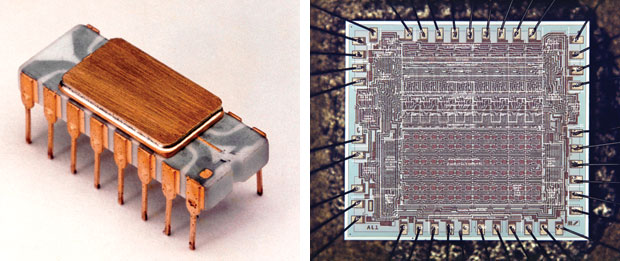
AL-1
The honor of creating a first microprocessor also depends on an understanding of this term. Some consider a microprocessor CPU on a single chip. Others say that arithmetic logic is enough on the chip. Others think that it is enough to place these functions on separate chips, and together they can already make up a microprocessor.
I believe that the key features of the microprocessor are the central processor on a single chip (including the ALU, control functions, registers) and the possibility of its programming. But the microprocessor is not the whole computer. Usually need more memory chips, I / O and other auxiliary functions.
Using this definition, most people believe that the first microprocessor was the Intel 4004, since all the components of the CPU were on the same chip. Boone and Federico Faggin from the Intel 4004 team agree that 4004 beat the earliest TMX 1795 for a couple of months. And the latter then introduced the first 8-bit microprocessor, and then the Intel 8008 became the first commercially successful 8-bit microprocessor.
But if we adopt a less strict definition of a microprocessor, other systems may be the first. If we consider the microprocessor ALU on the chip, then the first will be Boissel, who created the first chip in Fairchild in 1968, shortly before his departure and the founding of Four-Phase Systems. AL1 from Four-Phase Systems can also be a candidate, since it combined registers and ALUs on a single chip, with external control loops. If we accept that the microprocessor may consist of several IED-chips, then the first will be Autonetics D200.
From the point of view of patents, the story looks somewhat different. TI quickly realized the profitability of the patent system. They received many patents on the TMX 1795 and TMS 0100 and often used them in court proceedings and for issuing licenses.
On this basis, TI can be considered the inventor of both a microprocessor and a microcontroller, a single-chip layout of the CPU, memory, and various auxiliary functions. Or not. Because Hilbert Hyatt received a patent for a processor on a single chip in 1990, based on a 16-bit serial computer built by him in 1969 from motherboards with bipolar chips. This led to claims of Hayat's primacy in the invention of the microprocessor, but TI defeated his patent in 1996 after a difficult legal battle.
Another contender for the place of the inventor may be Boisel. In 1995, during a lawsuit that Gordon Bell later called "TI against all", Boisel fought TI patents with a single AL1 ALU chip from 1969, demonstrating a working computer to the court. This move torpedoed the TI case, although I personally don’t find his demonstration too convincing because it used several technical tricks.
No matter what invention you consider the first microprocessor, we can agree that there was no shortage of competitors for this title. It is a pity that most people want to find the only winner, while other applicants are now almost forgotten. But for those who are interested in the early days of microprocessors, their rich history will live on.
Source: https://habr.com/ru/post/397579/
All Articles